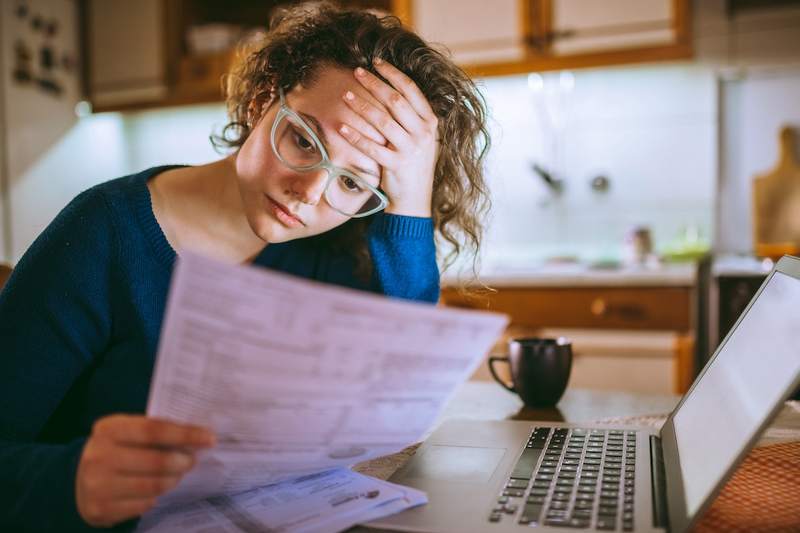One of the greatest incentives for refinancing your mortgage is to reduce the interest rate on your loan. But what if interest rates have increased since you got your mortgage?
It’s a question many homeowners are asking. The average interest rate for 30-year fixed-rate mortgages hit a historic low of 2.65% in January 2021, and since then peaked at just under 8% in October 2023.
While current rates remain low by historical standards, many homeowners may wonder if it’s worth refinancing when rates have increased. The answer is it depends on your circumstances and your financial goals. Read on to learn the pros and cons of refinancing at a higher interest rate.
Key Takeaways:
- Potential advantages to refinancing your mortgage at a higher interest rate include changing to a fixed-rate loan to protect yourself against further increases, shortening your loan term, or eliminating private mortgage insurance.
- Disadvantages include the need to pay closing costs, a higher monthly payment, and higher interest costs over the life of the loan.
- If you need cash, consider alternatives to refinancing such as a home equity loan, a home equity line of credit, or even selling your home.
Pros of Refinancing When Interest Rates Are High
Even though the rock-bottom rates of 2021 are behind us, there still can be benefits to refinancing when interest rates have increased.
Mortgages are cheaper than other types of credit
A cash-out refinance is a popular way for homeowners to borrow money. Using home equity as collateral for your cash-out refinance essentially lets you borrow money at mortgage interest rates, which typically are much lower than for other types of credit.
For example, the average interest rate for personal loans in November 2023 was 12.35%. The average interest rate on credit card accounts at commercial banks for the same month was 21.47%. Both are significantly higher than the average interest rate on fixed-rate mortgages, which ranged between 7.76% and 7.22% in November 2023.
“Many homeowners are refinancing to consolidate high-interest debts into their mortgage, taking advantage of lower overall interest rates,” says Mike Roberts, president and co-founder of City Creek Mortgage in Draper, Utah. “While interest rates may be higher than before, the potential for significant savings through debt consolidation makes it a compelling reason to refinance in the current market.”
A fixed-rate loan protects against further rate increases
If you have an adjustable-rate mortgage, an increased interest rate means a higher mortgage payment. If you want to avoid increases in your interest rate and mortgage payment, you can refinance to a fixed-rate mortgage. While the rate you’re paying on the new fixed-rate loan may be higher than what you were paying, you can rest assured that your rate will remain the same for the term of the loan.
A shorter loan term can save you money
There are trade-offs to refinancing into a shorter loan term. Doing so will increase your monthly payment, but you’ll finish repaying the loan more quickly and likely save money on interest — even if the rate you’re paying is higher.
Say you bought a home for $400,000 with a down payment of 10% and a 30-year fixed-rate mortgage at 7%, making your monthly payment $2,395. After five years, you refinance the $338,874 balance with a 15-year fixed-rate loan at 8%, your monthly payment would go up to $3,238, you’ll pay a total of $366,626 in interest across both loans, and you’ll be free and clear on your home 10 years earlier. If you had stuck with the original loan, you’d have paid $502,232 in interest, so refinancing to a higher rate saves you $135,606 in total interest.
You can eliminate PMI
If you buy a home using a conventional loan and make a down payment that’s less than 20% of the purchase price, you’ll have to pay for private mortgage insurance. This usually adds $30 to $70 per month for every $100,000 borrowed and decreases as you pay down your balance. On a $400,000 loan, you’d start out adding $120 to $280 to your mortgage payment of $2,661.
You have to pay PMI until you have at least 20% equity in your home. If you bought a home for $400,000, making a down payment of 10% and taking out a 30-year fixed-rate loan at 7%, it would take you 101 payments — eight years and five months — to reduce your balance to $320,000 and stop paying.
Refinancing lets you remove PMI more quickly, which can save you money. If your home has increased in value, you can refinance your mortgage using the higher value and remove PMI.
Cons of Refinancing When Interest Rates Are High
With interest rates directly affecting the cost of your mortgage, the drawbacks to refinancing when interest rates are high are obvious.
You must pay closing costs
Just like when you took out your initial home mortgage loan, there are fees and expenses involved with refinancing your mortgage. Closing costs on a refinance vary by mortgage lender, loan type, and location. Refinance closing costs average $5,000, and must be factored into any refinance decision.
Your monthly payment likely will increase
Unless you’re extending your loan term, expect your monthly payment and overall loan costs to increase if you refinance when interest rates have increased. It’s important to run the numbers and make sure that your new mortgage loan fits your budget.
You’ll pay more interest over the life of the loan
Refinancing to a higher interest rate could cost you a lot more in overall loan costs than sticking with your current loan. If you take out a loan with a higher interest rate, extend your loan term, cash out some of your home’s equity, or roll refinance closing costs into your new loan, you will often find that you’re paying substantially more for your home in total.
Alternatives to Refinancing When Interest Rates Are High
Not sure whether refinancing makes sense right now, especially with higher interest rates? Make sure to consider other funding options.
Home equity loan
A home equity loan can provide you with a lump-sum payment backed by your home equity. This type of installment loan is secured, so it’s usually offered at a lower interest rate than other forms of consumer debt.
HELOC
A home equity line of credit, or HELOC, is a revolving line of credit that also is secured by the equity in your home. This credit line typically is open for a set number of years, called the draw period, during which you can borrow as needed up to the credit limit.
Sell your home
If you really need to get out from under a too-high mortgage payment, tap into your property’s equity, or pay off a lot of debt, selling your home could be the best option. There are costs involved with selling your home, of course, but depending on when you bought and how much the property has appreciated, this could give you interest-free access to equity that you can then use to clear out high-interest debts, purchase another property, or simply lower your monthly household expenses.
FAQ: Refinancing When Interest Rates Are High
Here are answers to common questions about refinancing when interest rates are high.
If you’ve started looking into a mortgage refinance, higher interest rates may be a simple fact that you’ve accepted. This isn’t always the case, though. Refinance rates may be higher than home purchase rates with many lenders, but the bigger issue is that rates have increased in the last few years compared with the historic lows seen in 2020 and 2021.
Refinancing may make sense if you need to tap into equity, convert an ARM to a fixed-rate loan, or remove a co-borrower. However, there are many instances where refinancing — especially at a higher rate — isn’t such a good idea. These include refinancing if you can’t afford the added cost (such as closing costs or an increased monthly payment), will add substantially more to your total loan repayment, or don’t need to tap into equity for things like high-interest debt repayment or a large expense.
The Bottom Line on Refinancing When Interest Rates Are High
Refinancing your mortgage loan is an easy choice when rates drop, but considering a refi once rates have shot back up is a more difficult decision. Refinancing still can save you money by using equity funds to pay off high-interest debts, removing PMI, or refinancing into a fixed-rate loan that will protect you from further rate increases. It’s important to consider your options, do the math, and possibly consult with a financial professional to see if refinancing to a higher interest rate makes sense for you.
More From LowerMyBills:
- Pros and Cons of Buying a Home When Interest Rates Are High
- Why Are Mortgage Interest Rates Important?
- The Pros and Cons of Refinancing a Mortgage
- Ways To Refinance a Mortgage With Bad Credit
- Mortgage Refinance Checklist: Documents Needed for Refinancing
- How Often Can You Refinance Your Home?






